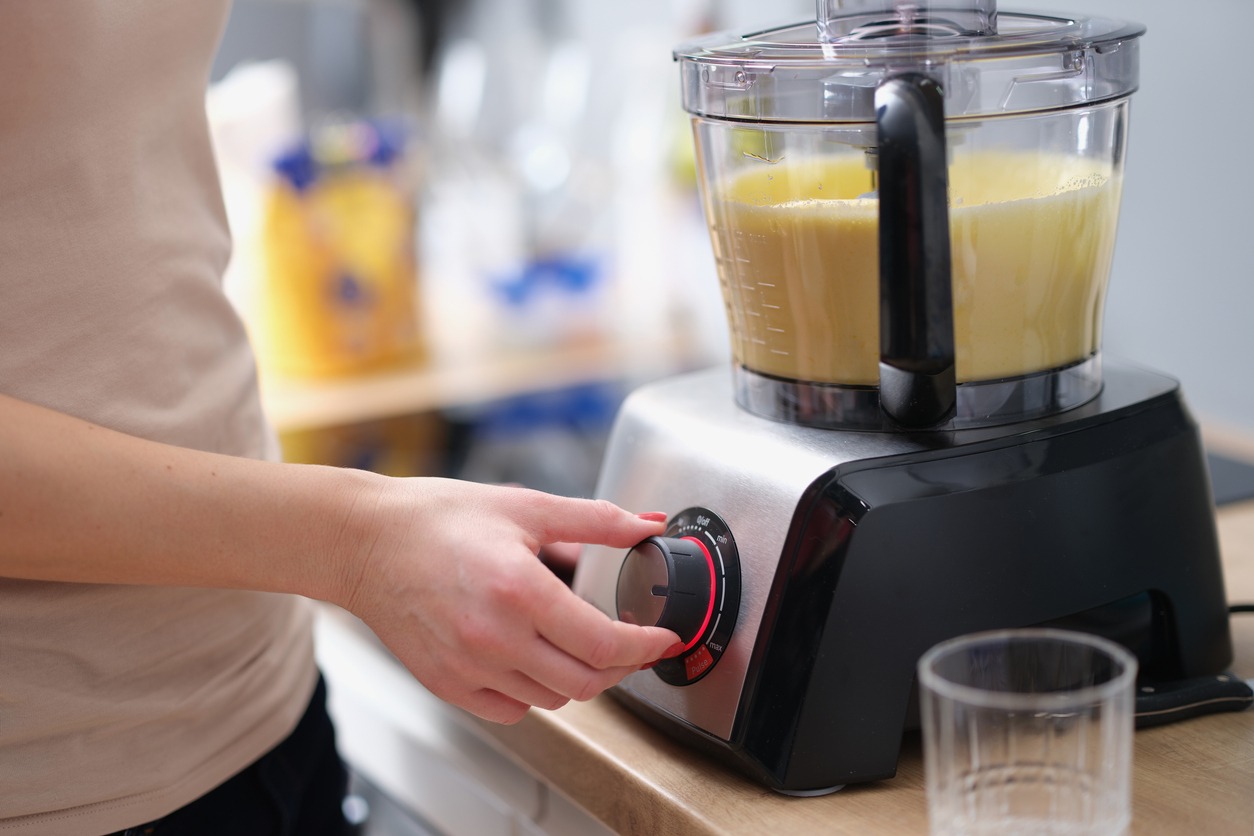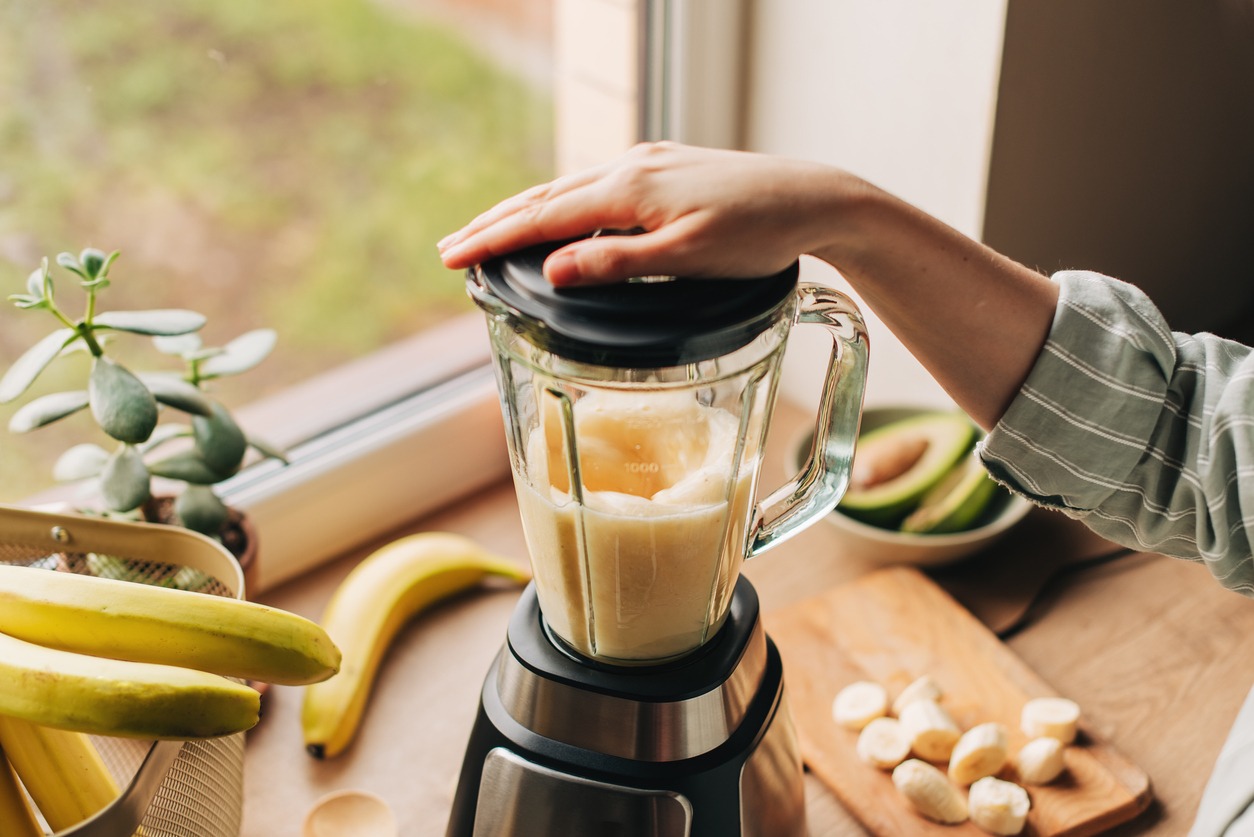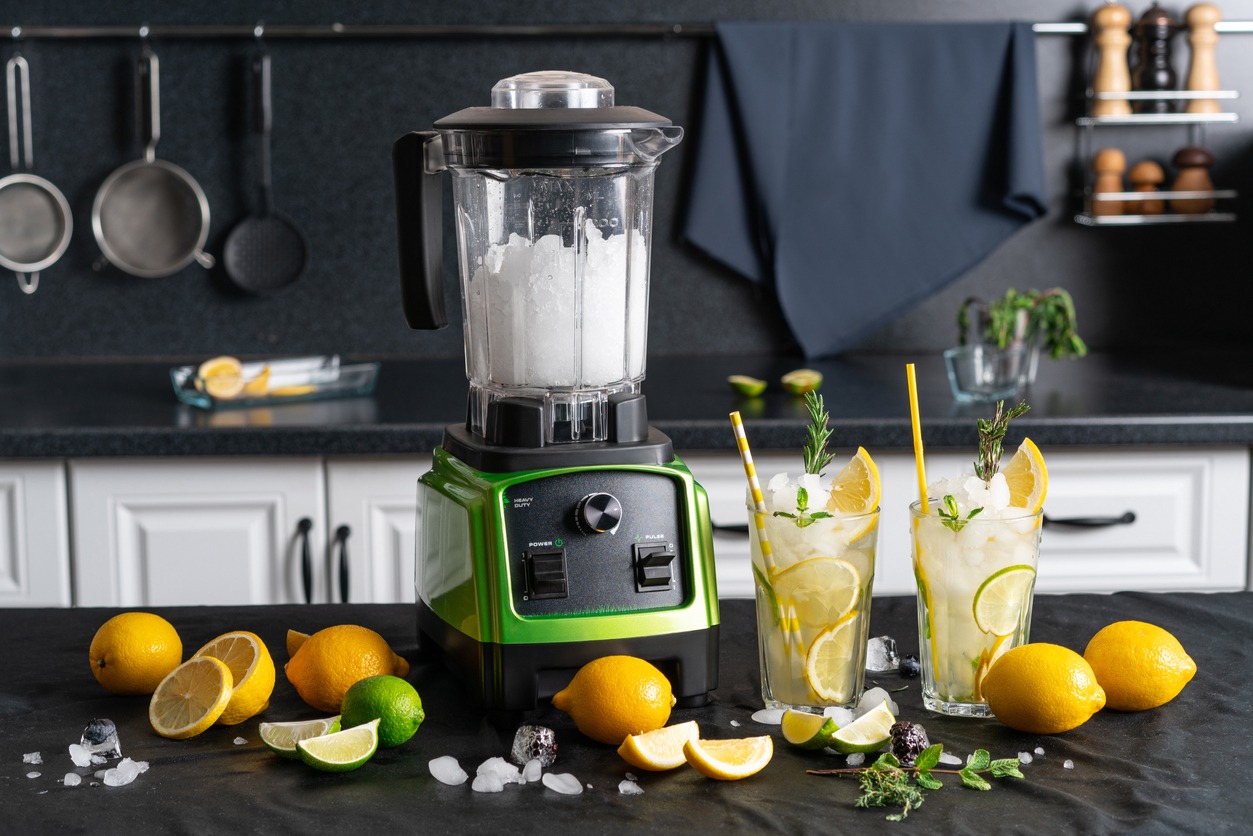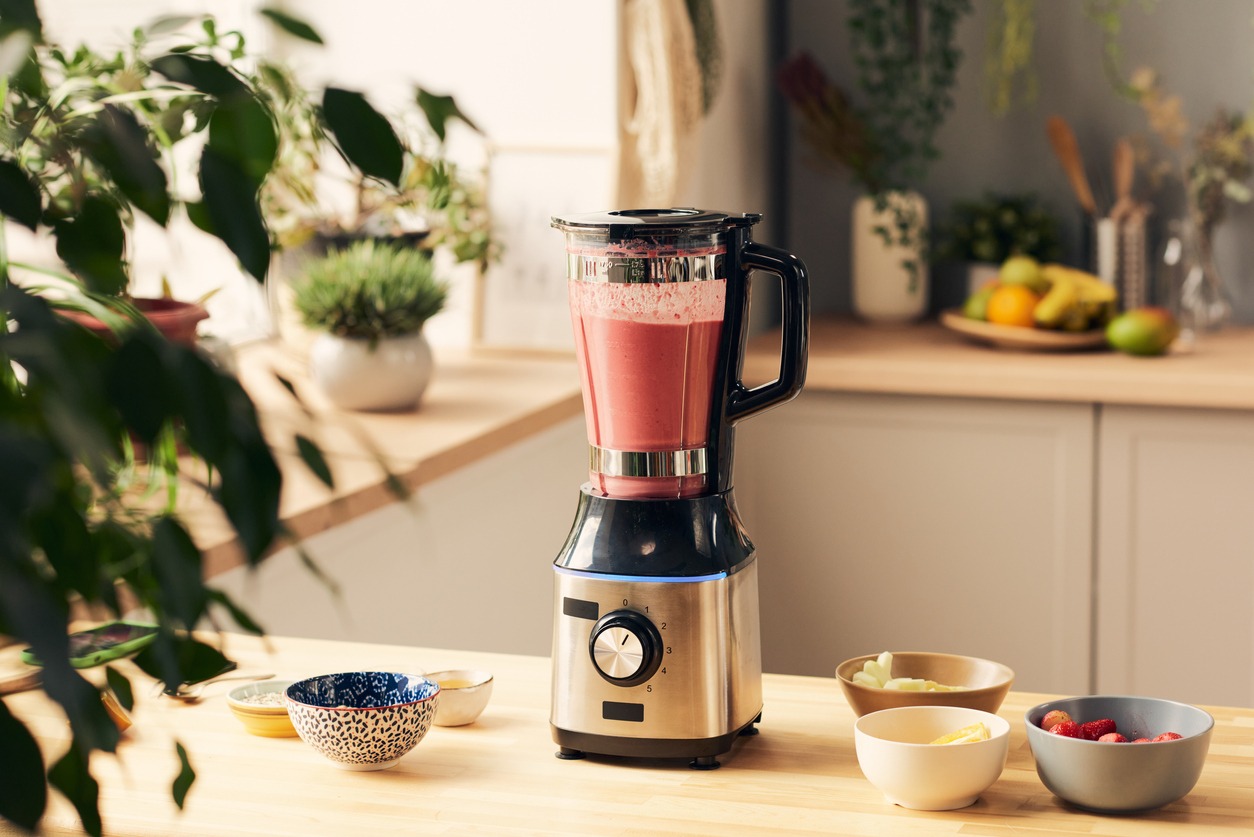The development of various home appliances used in the kitchen mirrors the progression of society and technology over several centuries. During the time before the Industrial Revolution, cooking was done over open flames using only the most fundamental of manual tools. Stoves made of cast iron were first introduced during the Industrial Revolution. Gas stoves and mechanical mixers did not become commonplace until the latter half of the 19th century. The middle of the 20th century saw the introduction of microwave ovens and more advanced refrigeration technology. The latter half of the 20th century saw a surge in digital and energy-efficient appliances. Smart technology is now integrating into modern kitchens, which is transforming how we interact with and control our culinary tools.
Blenders that are also smart are a prime example of the modern convergence of technology and kitchenware. These cutting-edge appliances go above and beyond the capabilities of traditional blenders by including connectivity features such as Bluetooth and Wi-Fi. Users can remotely control and monitor smart blenders through dedicated mobile apps. These apps typically offer a wide variety of recipes as well as settings that can be customized. These blenders may include sensors for detecting the ingredients being used, as well as programmable blending programs and even virtual assistants that can be controlled by voice. The idea of smart blenders not only makes the process of blending more efficient but also paves the way for new possibilities for personalized and automated culinary experiences. This concept represents a significant step forward in the development of innovative kitchen appliances.
The Rise of Smart Technology in Kitchen Appliances
Overview of the Smart Kitchen Appliance Market
There has been a notable expansion in the market for smart kitchen appliances. This expansion has been driven by developments in technology as well as shifting preferences among consumers. The term “smart kitchen appliances” refers to devices that use connectivity and automation to enhance their functionality. This improves the ease of cooking as well as the management of the kitchen.
The following are important aspects of the market for smart kitchen appliances:
- Connected Devices: Users are now able to remotely control and monitor their kitchen appliances thanks to the proliferation of Internet of Things (IoT) technology, which has made it possible for kitchen appliances to connect to the Internet. Because of this connectivity, the user experience as a whole is improved.
- Automation and Artificial Intelligence (AI): AI algorithms are frequently implemented in smart kitchen appliances to learn user preferences, adjust settings, and improve overall performance. The incorporation of automation features results in a smoother and more intuitive overall cooking experience.
- Energy Efficiency: Increasingly, high energy efficiency is a design priority for manufacturers of smart home appliances. They might have features like adaptive cooking algorithms, which optimize the amount of energy used based on the conditions in the kitchen at the moment.
- Interoperability: The development of interoperable systems, which enable various smart home appliances to communicate with one another, is becoming an increasingly important focus for manufacturers. This interoperability contributes to the development of an environment that is cohesive and integrated within the kitchen.
Integration of Technology in Traditional Appliances
The incorporation of intelligent technology has resulted in significant changes being made to conventional home appliances used in the kitchen. These home appliances include refrigerators, ovens, and dishwashers. The following are some notable examples:
- Smart Refrigerators: Smart refrigerators allow users to remotely view the contents of the refrigerator, monitor when items expire, and even place orders for groceries thanks to their touchscreens, cameras, and Internet of Things (IoT) connectivity. These appliances help to reduce the amount of food that is wasted and improve the overall organization of the kitchen.
- Smart Ovens: In addition to accurate temperature control, recipe recommendations, and capabilities for remote monitoring, smart ovens frequently offer these features. Some models incorporate cameras and sensors that can determine the kind of food that is being prepared and adjust the settings accordingly.
- Connected Coffee Makers: Coffee makers have become more sophisticated with the addition of features such as the ability to schedule brewing times using smartphone apps, the ability to adjust the brewing strength, and even the ability to integrate with virtual assistants for operation using voice commands.
- Intelligent Dishwashers: Smart dishwashers have features such as the ability to start or schedule cleaning cycles remotely, as well as the optimization of water usage and monitoring of detergent usage.
Consumer Demand for Smart and Connected Devices in the Kitchen
Several factors are driving the ever-increasing demand for smart kitchen appliances:
- Convenience: Customers place a high value on the practicality of having remote control and monitoring capabilities for their cooking appliances. This enables the preparation of meals to be more adaptable and time-efficient.
- Energy Efficiency: Consumers are increasingly interested in purchasing energy-efficient and environmentally friendly smart appliances as a result of the increased attention paid to issues related to sustainability and the conservation of energy.
- Personalization: Consumers looking for a more individualized cooking experience are likely to be interested in products that feature AI-powered features that can learn and adjust to the preferences of the user, such as suggested recipes or customized cooking settings.
- Interconnectivity: The need for a seamlessly connected kitchen ecosystem, in which various appliances can communicate with one another, has increased. This makes it possible to manage the kitchen in a way that is more integrated and streamlined.
As the market for smart kitchen appliances continues to develop, manufacturers will likely invest in innovation, creating devices that are both more intelligent and interconnected to meet the rising expectations of consumers who are knowledgeable about technology.
Features of Smart Blenders
Connectivity and Compatibility with Smart Home Ecosystems
- IoT Integration: Connectivity to the Internet of Things (IoT) is built into the design of smart blenders. This gives users the ability to remotely control and monitor their blenders using apps on their smartphones or other smart home devices.
- Smart Home Ecosystem Compatibility: These blenders frequently integrate with widely used smart home ecosystems such as Amazon Alexa or Google Assistant. This gives users the ability to control the blenders using voice commands and creates a more connected environment within the kitchen.
- Automation and Synchronization: Connectivity enables smart blenders to sync with other smart kitchen appliances, such as smart scales or recipe apps, for an easier and more streamlined experience when preparing food in the kitchen. For instance, a smart blender may alter its settings based on the readings from a scale that is connected to it, or it may recommend recipes based on the ingredients that are on hand.
Built-in Sensors and AI Capabilities for Precision and Automation
- Blending Sensors: There is a possibility that smart blenders will incorporate sensors that can determine the consistency of the ingredients that are being blended. Because of this, precise control over the blending times and speeds is possible, which guarantees excellent results.
- AI-driven Optimization: Some intelligent blenders have algorithms that use artificial intelligence to learn from user preferences over time. The longer you use the blender, the more it will learn from your blending habits and adjust its settings accordingly, which will ultimately result in a more tailored and effective blending experience.
- Ingredient Recognition: Modern blenders are fitted with cameras and sensors, which allow them to identify the ingredients that are being mixed inside. Because of this feature, the blender can adjust its settings automatically, allowing for optimal blending results regardless of the recipe being followed.
Customizable Settings and User-Friendly Interfaces
- Programmable Settings: Blenders that are considered to be “smart” typically come equipped with several pre-programmed settings for common culinary endeavors like blending smoothies, soups, or sauces. Users also can personalize and save their preferred blending settings for particular recipes.
- Touchscreen Controls: Numerous smart blenders now come equipped with user-friendly touchscreen interfaces, making for easy and precise control. These interfaces may display information about the blending process in real-time, such as the blending time and speed, and may also give users the ability to make adjustments on the fly.
- App Control: The smartphone apps that come bundled with smart blenders add an extra layer of control and customization to the device. Users have access to a comprehensive library of recipes, can remotely adjust the blending parameters, and are notified when the blending process is complete.
Health and Nutritional Tracking Features
- Calorie and Nutrient Tracking: There are different kinds of smart blenders, and some of them have features that keep track of the nutritional value of the ingredients that are used in each blend. This information can either be displayed on the interface of the blender, or it can be synced with a companion app to perform comprehensive health monitoring.
- Integration with Fitness Apps: Smart blenders may integrate with fitness and nutrition apps, providing users with an all-encompassing view of their dietary habits and enabling them to make more well-informed food choices. This is useful for users who are conscious of their health and fitness goals.
- Recipe Suggestions for Health Goals: Smart blenders may suggest recipes to users based on their preferences and the health goals they want to achieve. They can provide recommendations for nutrient-dense smoothies as well as other blends that are tailored to specific dietary requirements.
In a nutshell, smart blenders introduce a variety of cutting-edge features into the kitchen, such as connectivity and automation, precise blending control, and health monitoring. These blenders are likely going to come equipped with even more cutting-edge features in the not-too-distant future as the demand among consumers for high-tech kitchen appliances continues to rise.
Benefits of Smart Blenders
Time-Saving and Convenience in Meal Preparation
- Quick and Efficient Blending: When compared to conventional blenders, smart blenders typically come equipped with robust motors and innovative blending technologies. These features enable users to obtain results that are smooth and consistent in a shorter amount of time than is possible with traditional blenders.
- Programmable Settings: Users can automate the blending process for frequently used recipes by using the programmable settings found on smart blenders. This eliminates the need for manual adjustments and monitoring during the blending process, which saves time and reduces the amount of labor required.
- Remote Operation: An additional layer of convenience is added by the capability of smart blenders to be controlled remotely through smartphone apps or other smart home devices. Users can begin blending, make adjustments to the settings, or monitor the progress from a distance, which enables them to multitask in the kitchen.
Enhanced Precision in Blending and Food Processing
- Variable Speed and Settings: Smart blenders typically come equipped with several different speed settings and blending modes, giving users the ability to exercise fine-grained control over the consistency of their blending. Making smoothies, soups, and sauces are all examples of activities that benefit greatly from having this tool.
- Sensor Technology: Smart blenders are equipped with sophisticated sensors that can detect a variety of factors, including the types of ingredients, the quantities of those ingredients, and even the temperature. This information is used to make automatic adjustments to the blending settings to achieve the best possible results.
- AI-Driven Adaptability: The incorporation of artificial intelligence makes it possible for smart blenders to adapt to and learn from the preferences of their users, making it possible for each blend to be customized to the individual’s preferred flavor and texture.
Health-Conscious Features Promoting Balanced Nutrition
- Nutrient Tracking: Users can monitor the nutritional value of their blended concoctions when using smart blenders equipped with features focused on health. This information may be shown in real-time on the interface of the blender, or it may be synchronized with a companion app to perform comprehensive health monitoring.
- Recipe Recommendations: The artificial intelligence (AI) algorithms found in smart blenders can make recipe recommendations based on the user’s preferences, dietary restrictions, and health goals. This encourages the creation of nutrient-rich and well-balanced blends that are tailored to the specific requirements of each individual.
- Portion Control: There are various features available on smart blenders that allow users to better control the amount of food they consume, which can contribute to a healthier diet. This is especially helpful for people who are concerned about the nutritional balance of their diet as well as the amount of calories they consume.
Energy Efficiency and Sustainability Aspects
- Adaptive Energy Usage: Intelligent blenders may incorporate energy-efficient features, such as adaptive blending algorithms that optimize energy usage based on the task at hand. These algorithms may be included in the smart blender’s software. The energy efficiency of the kitchen as a whole is improved as a result of this.
- Durable Construction: The majority of modern blenders are made with high-quality components and sturdy construction, which allows them to last for a longer period and reduces the frequency with which they must be replaced. This helps to reduce the amount of electronic waste, which is good for the environment.
- Smart Home Integration: Smart blenders can make a significant contribution to the energy efficiency of smart homes when they are integrated into the ecosystem of a smart home. This integration enables users to monitor and control their kitchen appliances, ensuring that the appliances are only turned on when they are being used.
In conclusion, smart blenders provide a variety of benefits, such as the convenience of saving time, enhanced precision in blending, features that are mindful of one’s health, and considerations for energy efficiency and sustainability. Users will have even more reasons to incorporate smart blenders into their kitchens as technology continues to advance, which is likely to result in an expansion of the benefits that are currently available.
Challenges and Considerations
Affordability and Accessibility for a Wide Consumer Base
- Cost Barrier: Intelligent blenders frequently come packaged with advanced technologies, which can cause their prices to be significantly higher than those of their conventional counterparts. A large portion of consumers continue to place a significant emphasis on affordability, and manufacturers are challenged to find a happy medium between the incorporation of cutting-edge features and the total cost of the appliance.
- Market Accessibility: The availability of smart blenders and access to them may be restricted in certain geographic areas or among particular demographic groups. To make certain that these technologies are accessible to a wide variety of customers, the manufacturers of these products need to find solutions to the problems that arise when trying to enter new markets.
- Cost of Maintenance: Users may also be concerned about ongoing maintenance expenses, which may include potential costs for software updates, replacement parts, or technical support. While the cost of the initial purchase is certainly a factor, users may also be concerned about ongoing maintenance expenses.
Privacy and Security Concerns with IoT-Connected Devices
- Data Privacy: Along with other Internet of Things-connected devices, smart blenders collect and process data, which may include the preferences of the user, patterns of usage, and information that may be relevant to the user’s health. It is essential to implement stringent data privacy practices to protect the sensitive information of users.
- Security Risks: Threats to computer security can be posed by Internet of Things devices. To prevent unauthorized access, data breaches, or malicious attacks that could compromise user privacy, smart blenders need to have robust security measures in place.
- User Consent: The data that is collected by smart blenders must be disclosed openly by their manufacturers, and the users’ informed consent must be obtained. Concerns about users’ privacy can be alleviated by giving them control over the data that is shared and giving them the option to opt out of using particular features.
Learning Curve and User Adaptation to New Technologies
- User Education: Users may experience a learning curve as a result of the introduction of new technologies, such as connectivity for the Internet of Things and AI algorithms. To make the process of adaptation as smooth as possible, manufacturers ought to put money into creating user-friendly interfaces, comprehensive user manuals, and educational resources.
- Complexity: Some users may be dissuaded from making full use of the capabilities of smart blenders if the device has features or settings that are overly complicated. It is essential, to encourage widespread adoption, and to strike a balance between the advanced functionality and user-friendly design of the product.
- Tech Literacy Variation: The level of technological literacy that consumers possess varies widely. Smart blenders need to be designed with user interfaces that are easy to understand and cater to users of all levels of technological expertise, so manufacturers need to take into account the diversity of their customer base when developing these products.
Manufacturers can improve the overall acceptance and adoption of smart blenders by addressing these challenges and considerations. This will ensure that these cutting-edge kitchen appliances are not only technologically advanced but also easily accessible, secure, and user-friendly for a wide variety of customers.
Conclusion
Consumers are encouraged to embrace the future of kitchen technology, particularly the integration of intelligent appliances such as advanced blenders, as the landscape of the kitchen continues to transform as a result of the introduction of novel technologies. Individuals who invest in these cutting-edge devices can not only streamline their cooking processes for greater convenience, but they can also enjoy the benefits of enhanced precision, nutrition tracking, and energy efficiency in their cooking. Accepting new technology in the kitchen isn’t just about buying new appliances; rather, it’s about establishing a connected and productive atmosphere in the kitchen that can keep up with the fast-paced nature of modern life. Consumers are strongly encouraged to investigate the options, maintain an awareness of developing technologies, and make well-informed decisions to have an improved experience in the kitchen.
The convergence of advancing technologies, rising levels of consumer interest in energy savings, and growing awareness of the need to reduce environmental impact have created a fertile environment for continued innovation in kitchen appliances. The progression of smart kitchen appliances, such as blenders, demonstrates a commitment to the creation of solutions that are more user-friendly, personalized, and environmentally conscious. Exciting new developments, such as improved connectivity, features driven by artificial intelligence, and environmentally conscious design, are likely to emerge as our increasingly dependent relationship with technology continues to deepen. The kitchen, which was once considered a conventional room, is rapidly transforming into a nerve center for high-tech, interconnected appliances that cater to the varied requirements and preferences of consumers. Not only does the future promise increased convenience, but it also promises a life-changing experience right in the middle of the home thanks to a design philosophy that prioritizes creativity, sustainability, and the needs of the user.





